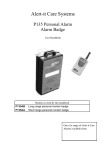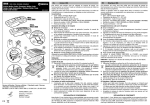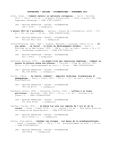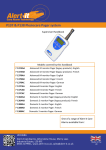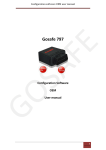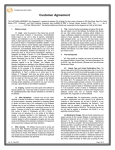Download Alert-it Care Systems P135 Operating instructions
Transcript
Alert-it Care Systems P166A Guide Light Monitor (radio) Handbook P166A Models covered by this handbook Radio Guide Light Monitor One of a range of Alert-it Care Alarms available from: This handbook is intended to assist carers install, configure and use the monitors. The carer therefore needs to understand the needs of the user and asses that the monitor meets those needs and if any supplementary monitoring is needed taking into account any health risks. The P166 is a bed vacation monitor designed to operate with the Alert-it Pagers (P137 or P138). It is designed to detect the user leaving the bed, provide a reassuring light for guidance and set an alarm if the user is out of bed for an inappropriate length of time (which can be immediately or after a programmed delay time). All unit also offers a front panel CALL button to allow the user to call for assistance. In health critical applications the monitor can use the failsafe features of Safelink (see Page 7) Bed Vacation Monitoring This unit is designed to work with a range of Bed Occupancy sensors, which are characterised as being switches normally close while the user is present. One input triggers an instant alarm while the other an alarm after a programmed delay, with a default of 6 minutes. An internal link can join both inputs so the sensor activates both functions (default) It is intended to support the care of those who are frail, vulnerable to falls or wandering, where the carer needs to know if they leave the bed or fail to return within an acceptable period. Power for P166 The unit is powered from a mains adapter but does not have a standby battery. Hence it should only be used in health critical situation with the Securelink mode enabled (which will detect loss of power) UH1142 P163 General Interface page 2 of 8 Quick Reference Sheet: Installation Call for assistance Alarm Indicator 12v power supply Connection for sensors See page 7 for pinout RESET to enable STANDBY mode The bed occupancy sensors are fitted with a connector to mate with the front connector. See the individual sensor handbooks for operating instructions. Alternative passive switch type sensors could be used. The installer must, however, ensure the sensor meets the needs of the user and poses no mechanical or biological hazard to him. For connections details see page 7. Range test. Accessories available The unit and pager should be Part Description Part No Cleaning tested in all the usual See p 6 locations to prove signal reception. A short press (less Bed Occupancy Mat P143C A than 1sec) of the RESET Bed Occupancy Ribbon P143G A button will cause the P166 to transmit a signal. The pager Bed Leg Sensor P144A B should respond by showing Mounting bracket P159A B NODE 00 (or the name Power Supply P171 C allocated to the unit) on the Pager P138B B display for 1 second. Power Supply for Pager P153* C An alternative method is to enable the Securelink (See page 7). The monitor will then transmit every 10 seconds, and the pager will display New!010A (or similar) at each transmission. If this stops then then the radio range is failing. UH1142 P163 General Interface page 3 of 8 Installation (cont) Sensor Testing Occupancy Sensors Ensure the bed/is unoccupied and after pressing RESET there will be a four tone beep and the unit should be in STANDBY. Five tones will indicate the sensor is being falsely triggered by the weight of the bedding/cushion or otherwise installed incorrectly. Activate the sensor and a single beep should be heard indicate successful detection of the occupant. After that operation is silent. Deactivating the sensor will then cause the blue light to illuminate and raise the alarm, either instantly or after the delay period (it is not essential to wait for this as the above proves the senor operation). Reset the unit to stop further nuisance alarms, and the light will extinguish after 15 seconds These tests should be performed regularly to confirm correct system operation All parts of the system, apart from the pager charger, are suitable for use within the patient vicinity Operation The monitor is turned on by connecting the mains adapter Operating the P166: Call for Assistance Activating the call button for longer than 1 second will result in an ASSIST alarm with audible warning on the pager, and a beep from the P166 monitor. The blue light will then illuminate. Activating for longer than 5 seconds will result in a second beep and the alarm will be elevated to URGENT. The alarm has to be RESET by the carer as below Bed Vacation After power-up (or RESET) the monitor will be in STANDBY. When the Occupancy sensor is activated there will be a beep (default) and the monitor will become active. When the user leaves the bed, the blue light illuminates after 4 seconds and the monitor will send an URGENT alarm (either immediately or after a time delay dependent on the “1-Input Link” (see page 8). The alarm will automatically reset if the user returns to bed and the light extinguishes after a 15 second settling period. To special order the monitor can be programmed to play a warning tune for 30 seconds prior to sending the alarm UH1142 P163 General Interface page 4 of 8 Operation (cont) Reset the Alarm The alarm is reset by the user returning to bed or for daytime press the RESET button for greater than 1 second (until a beep is heard). The light will then extinguish after 15 seconds and the monitor will enter the standby state until the user reappears in the bed later. Turn off P166 The P166 is turned off by removing the mains adapter from the power, which then isolates the unit. If the Securelink mode is operating the pager will then show an RF Fail fault after 2 minutes, Alarm indication on monitor and at the pager/receiver Alarm Detect Delay P166 Pager Call Instant On Assist 01 Intermittent tune + alarm Call 5 seconds On Urgent 02 Continuous tune + alarm Bed exit Delay set by link On Urgent 01 Continuous tune + alarm TEST Press Reset Flash Shows node name UH1142 P163 General Interface page 5 of 8 Maintenance Cleaning: The following is a general guide line based on the components listed on page 3. Where a different sensor has been supplied, then please refer to the cleaning instructions supplied with that sensor. Technique A Wetting with strong disinfectant. This can include immersion provided plugs and any obvious breathing holes are avoided. Technique B Wiping with cotton wool pads moistened (compressed until dripping stops) with a mild detergent (0.5% washing up liquid) solution. Technique C Wiping with disposable 70% isopropyl alcohol wipes. Ensure that any plugs are completely dry before reinserting into the sensor input socket on the monitor. Technique D Full immersion in detergent , water and optional disinfectant. See component washing instructions for details UH1142 P163 General Interface page 6 of 8 Technical Information & Configuration Securelink Mode In Safelink the monitor will send a radio “heartbeat” signal every 10 seconds. If this signal disappears for more than 2 minutes, the pager will issue an “RF Fail” alarm. This mode will decrease battery life but is essential in any health critical application The default setting is without Securelink (as shown). To enable the failesafe mode refit the link to the centre pins AND CYCLE POWER (which will require removing/replacing any rechargeable batteries) Input Connections The connection details FCC64 for the unit are shown pin Function cable above and, in general, 1 +12v (option) Brown the alarms will be activated when a 2 Delay in Yellow connection is made 3 Instant in Green from pin 2 or pin 3 to 4 0v Red 0v (pin 4 or 5). 5 0v Black Pin 3 causes instant transmission of the Input connection details 5 No connection Blue alarm, while pin 2 will delay transmission for a time that will have been programmed into the unit. The internal 1-Input link joins pin 2 & 3 so that any input causes an instant alarm followed by a delayed alarm. Configuration Changes The P135 uses the standard Alert-iT Programming Data Protocol and all the main features can be changed using the P152 USB Interface and Data Editor Programme. Communication Address Changes Each badge in a care home MUST have a different communication address. To facilitate easy installation the Communication Address can also be changed directly from the pager using the P173A programming cable UH1142 P163 General Interface page 7 of 8 Technical Information & Configuration 1-Input Link The two input s can be joined by this link so that one sensor can activate the INSTANT and DELAYED alarms. To access this link , remove the 4 case screws and separate the two halves. The picture shows the two possible positions for the Bed Vacation Alarm. INSTANT + DELAY DELAY only UH1142 P163 General Interface page 8 of 8 UH1142 P163 General Interface page 9 of 8 UH1142 P163 General Interface page 10 of 8 Safety Instructions and Warnings ! 1. 2. 3. 4. 5. 6. 7. 8. 9. 10. 11. 12. 13. 14. 15. 16. 17. 18. This symbol indicates there are warnings and precautions associated with the use of this equipment that should be carefully read and understood before using the equipment. Ensure that the senor cable is routed and secured to avoid the risk of entanglement or strangulation. Only the recommended power supply shall be used as it is certified to provide two means of patient protection to EN60601-1in non-hospital environments Consult the manufacturer for power supplies suitable for hospital use Ensure any power cable is routed to avoid a trip hazard Regularly check the power supplies for damage and potential shock risks Clean and disinfect each item regularly in accordance with information herein Regularly test all sensors as described herein Ensure, by testing, that the alarm is annunciated at the carer's location(s) Operate any power supply and charge pager away from direct heat and uncovered. As with all medical electronic equipment there is potential for the equipment to interfere with or be effected by interference from other electrical or electronic devices. For this reason avoid placing the monitor, sensor or connecting cable in close proximity to sensitive electronic devices or devices which produce strong electromagnetic fields such as radio transmitters, mobile phones or power cables. Only use the monitor with accessories approved for use with this product and only in accordance with instructions. If the equipment is modified in any way, appropriate inspection and testing must be conducted to ensure continued safe use of the equipment. The carer must conduct a risk assessment to determine if the level of reliability offered by the monitor is sufficient or if additional monitoring is needed. Contact the manufacture for assistance with Risk Evaluation Tools. Additional levels of mechanical protection may be needed for some patient disorders. Contact the manufacturers for advice Some accessories are fitted with small screws and have plastic bags. Ensure these do not come into the possession of vulnerable patients who might choke on them Any sensor over the mattress (Bed Vacation) has the potential to cause pressure sores . The carer must assess this risk and monitor the use of these products Any sensor over the mattress could pose a fire hazard if in contact with a smouldering cigarette. The monitor and all accessories are designed to operate indoors in a residential environment of 10ºC to 30ºC and 90%RH max. Certified as Class 1 Medical, Class II Electrical Safety UH1142 P163 General Interface page 11 of 8 Certified as compliant to the following standards 93/42/EEC as revise 2007/47/EC Medical Devices Directive Risk Assessment EN 14971:2007 Medical Device Safety Requirements EN 61010-1:2005 Technical Aids for Disabled Persons EN12182:1999 EMC EN 61010-1-2:2004 Radio Transmissions: Short Range Devices EN 300 220-1 V2.1.1 (2006-04) Permitted Materials 2002/95/ECRoHS 1Alert-it Care Alarms are social aids designed and manufactured in accordance with 93/42/EEC as Class 1 Medical Devices. They are intended to improve the vigilance of carers to distressing side-effects of various diseases, such as Epilepsy and Dementia. They do not monitor vital physiological processes and should not be expected to diagnose any disease or predict the onset of any symptoms. Additional Documents Quick Start Radio P166 Systems UQ1244A Review of different Occupancy Sensors UL1200 Check sheet on choice of occupancy sensors UT1246 You tube Instruction Videos Index UV1198 Support For technical support please fax or EMail: HELP: 0845 217 9951 FAX :0845 217 9953 [email protected] Designed by: ITs Designs Ltd Leicester LE9 9FE UK ...using technology to care for carers The Alert-it system has been designed with due regard to reliability and integrity. While it offers a highly vigilant monitoring method,it is always possible that a distress condition can go undetected for a variety of reasons (including malfunction) and in life threatening situations it is advisable to use the Alert-it system in conjunction with additional monitoring techniques (e.g. video). Neither the manufacturer nor its agent can accept legal responsibility to provide a system that is infallible. The carer is responsible for assessing the risks of using this equipment and any settings pertaining to it. UH1142 P163 General Interface page 12 of 8












